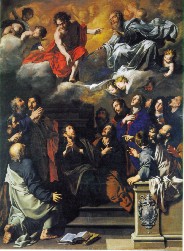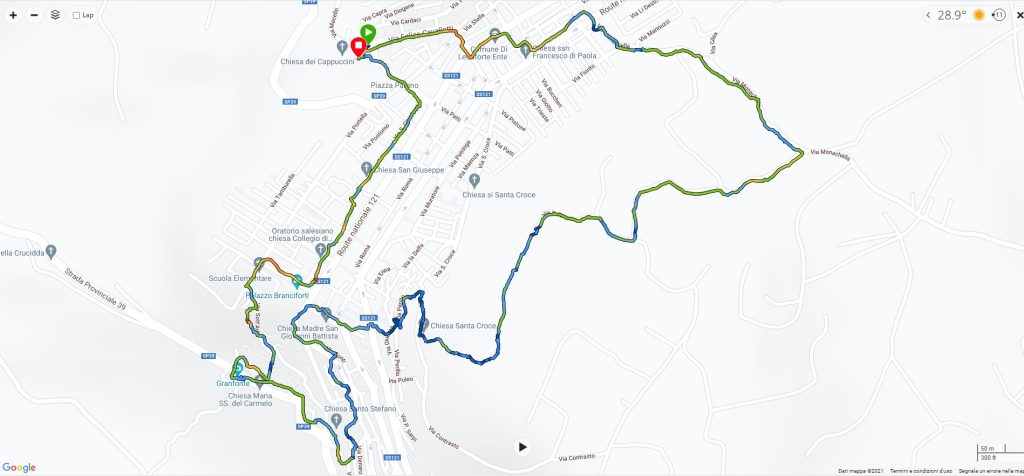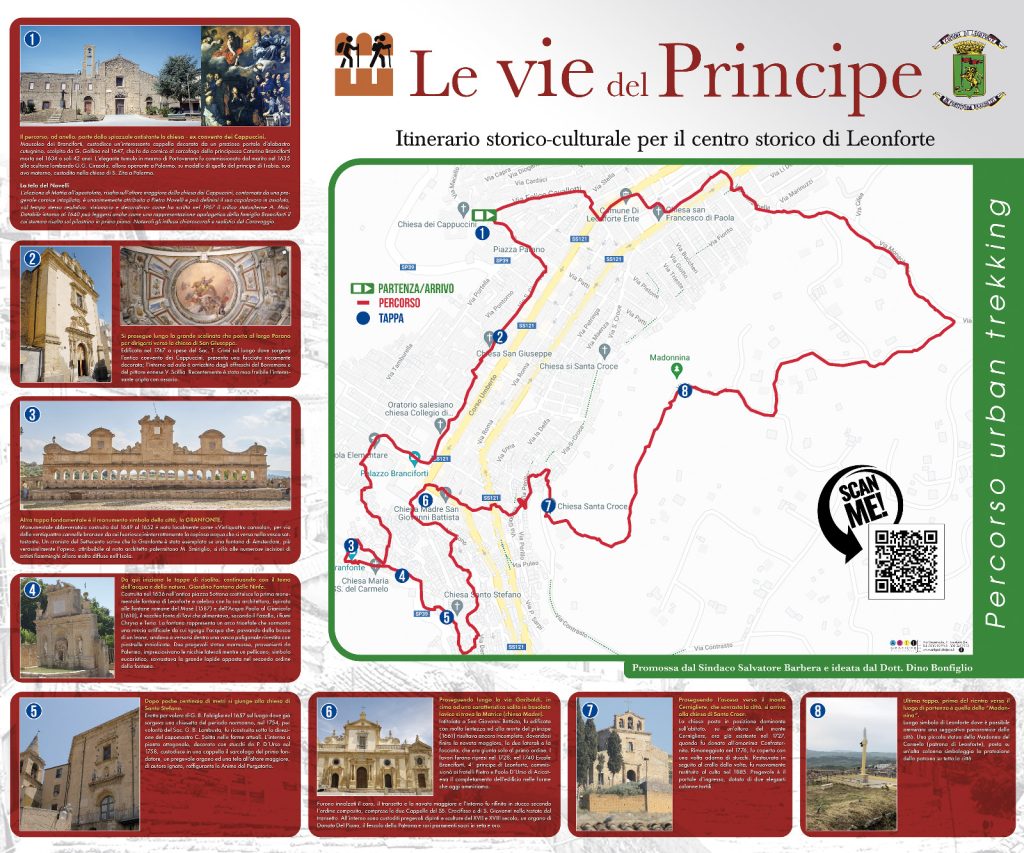🇬🇧 Urban trekking “the prince’s paths”

Route of urban trekking on historical and cultural itinerary through the historic centre of Leonforte

A suggestive walk that crosses much of the historical and anthropological memory of Leonforte, a town founded by Prince Nicolò Placido Branciforti in 1610.

The circular route starts from the open space in front of the church – former Capuchin convent.
Mausoleum of the Branciforti, it houses an interesting chapel decorated with a precious cotogninoalabaster portal, sculpted by G. Gallina in 1647, which frames the sarcophagus of Princess Catherine Branciforti,died in 1634, at the early age of 42. Her husband commissioned the elegant marble tumulus of Portovenere in 1635 to the Lombard sculptor G.G. Cirasolo, then working in Palermo. It was basedon the model of that of the prince of Trabia, her maternal ancestor that is kept in the church of S. Zita in Palermo.
The canvas by Novelli. Mattia’s election to the apostolate, which stands out on the high altar of the Capuchin church, surrounded by a fine carved frame, is unanimously attributed to Pietro Novelli. It can be called his absolute masterpiece, «at the same time realistic, visionary and decorative» as the American critic A. Moir wrote in 1967. Dating from around 1640, it can also be seenas an apologetic representation of the Branciforti family whose coat of arms stands out on the pillar in the foreground. Caravaggio’s chiaroscuro and realistic influences are remarkable.


From here continue along the large staircase that leads to Largo Parano to head to the church of San Giuseppe
Built in 1747 at the expense of apriest, T. Crimì, on the site of the ancient convent of the Capuchins, it has a richly decorated facade; Borremans and a painter from Enna, V. Scillia, enriched the interior with frescoes. Recently, the interesting crypt with ossuaryhas been madeavailable.
Another important stop is the monument symbol of the town, the Granfonte

A monumental drinking trough built from 1649 to 1652. It is knownlocally as the «Vintiquattrucannola», because of the twenty-four bronze reeds from which the abundant water pouring into the basin below flows continuously. A chronicler of the eighteenth century writes that the Granfontewas built on the model of a fountain in Amsterdam; more likely, the work, attributable to the well-known architect from Palermo, M. Smiriglio, refers to the numerous engravings of Flemish artists then widespread in the island.

From here, the stages of ascent begin, continuing with the theme of water and nature, Fountain of the Nymphs Garden.
Built in 1636 in the ancient square Sottana, it is the first monumental fountain of Leonforte and,with its architecture inspired by the Roman fountains of Moses (1587) and Acqua Paola at the Gianicolo (1610),it celebrates the old source of Tavi that, according to Fazello, fed the Chrysa and Teria rivers. The fountain represents a triumphal arch that surmounts an artificial rock from which flows the water that, passing from the mouth of a lion, pours into a polygonal tank covered with majolica tiles. Two fine marble statues from Palermo embellish the side niches, while a pelican, a Eucharistic symbol, overhangs the large tombstone affixed in the second order of the fountain.
After a few hundred metres, you can reach the church of Santo Stefano

It was built at the behest of G. B. Falciglia in 1657 where there was already a church of the Norman period; in 1754, by the will of a priest, G. B. Lambusta, under the direction of the master builder C. Saitta,it was rebuiltin its current form. The octagonal interior, decorated with stuccoes by P. D’Urso in 1758, houses, in a chapel, the sarcophagus of its first founder, a valuable organ and a canvas of unknown author,at the high altar,depicting the Souls of Purgatory.

Continuing along the Via Garibaldi, on the top of a characteristic climb in lava paving, we find the Matrice (Mother Church)
Dedicated to Saint John the Baptist, it was built very slowly and,at the death of the prince (1661),it was still incomplete; the main nave, the two side aisles and the facade, which had reached only the first order, had still to be finished. The work was resumed in 1728; in 1740 ErcoleBranciforti, 4th Prince of Leonforte, commissioned two brothers, Pietro and Paolo D’UrsofromAcicatena, to complete the building in the forms we admire today. The choir, the transept and the nave were raised and the interior was finished in stucco following the composite order, including the two chapels of the SS. Crucifix and St. John in the heads of the transept. Inside there are valuable paintings and sculptures of the seventeenth and eighteenth century, an organ by Donato Del Piano, the feretory of the Patron Saintand rare vestments in silk and gold.
Continuing the ascent towards Mount Cernigliere, which overlooks the town, you get to the church of Santa Croce

The church, situated in a dominant position over the town, on a hill of Mount Cernigliere, was already in existence in 1727 when it was donated to the homonymous Brotherhood. Modified in 1776, a vault adorned with stucco covered it. Restored after the collapse of the vault, it was reopened to worship in 1885. Valuable is the entrance portal, equipped with two elegant twisted columns.
The last stop, before returning to the place of departure, is the “Madonnina“

Symbolic site of Leonforte from where you can admire a picturesque view of the town. A small statue of Our Lady of Carmel (patron saint of Leonforte), placed on a high column, symbolizes the protection of the patron saint all over the town.
Traduzione curata dalla Prof.ssa Graziella Leanza


Ultimo aggiornamento
8 Marzo 2024, 08:58
 Comune di Leonforte
Comune di Leonforte